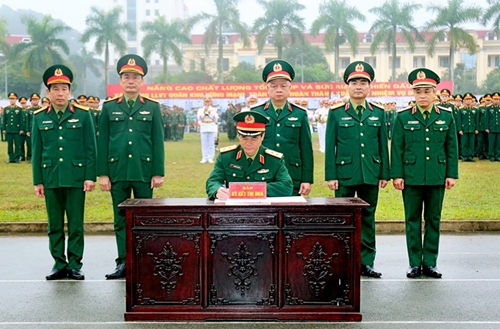In fact, the Northern Delta held a special strategic position, being a big front and a big rear, reinforcing battlefields with personnel and materials.
In a recent interview with Lieutenant General Nguyen Quang Cuong, Secretary of the Party Committee and Political Commissar of Military Region 3, the general emphasized that under the leadership of party committees at all levels, troops and people in the Northern Delta exerted all-out efforts to strengthen the people’s warfare disposition, step-by-step mastering the delta area and narrowing the scope of the enemy’s occupation.
    |
 |
|
Military Region 3’s affiliates signing an emulation agreement at the launch of the new training season 2024 under the witness of Military Region 3 leadership |
In early 1953, in the Northern Delta, the people’s warfare disposition was strengthened, the guerrilla areas and bases were expanded, and the movement of building combat villages developed widely, creating conditions for the guerrilla warfare to develop.
On February 23, 1954, the Politburo issued a directive on the tasks of Northern Delta troops and people to take advantage of any opportunities to conduct small offensives, destroy traffic facilities, depots, bridges and roads, and prevent the enemy from transportation.
To realize that directive, Northern Delta troops and people enhanced guerrilla warfare. They launched an offensive at Gia Lam Airport, an important airport in Northern Indochina that offered air reinforcements to Dien Bien Phu. In this battle, we destroyed 18 aircraft, annihilated 16 enemy troops. On March 7, 1954, 32 troops from Kien An province (now Hai Phong city) attacked Cat Bi Airport, destroying 59 planes, and a number of weapons, combat equipment of the enemy. Heavy losses made the reinforcements of the enemy to battlefields more difficult.
Attentively, in the Winter-Spring 1953-1954 series of battles, together with troops and people nationwide, those from Inter-Region 3 and the Left Bank Region (today’s Military Region 3) effectively promoted the strength of the people's heart posture, consolidated the new government, pro-actively developed combat plans, actively fought against the enemy, narrowing their occupation, creating conditions for the campaign’s troops and protecting traffic arteries. Northern Delta troops and people won numerous victories, annihilating over 40,000 enemy troops, forcing 250 positions to withdraw or surrender, shooting down 82 aircraft, destroying and seizing a lot of weapons and vehicles, making it impossible for the enemy to withdraw its mobile forces to reinforce the battlefields.
Political struggle movements and military mobilization also developed strongly in the period. In enemy-occupied areas, people rebelled, destroyed most concentration camps, and returned to their hometowns. In addition, in the first three months of 1954, there were more than 200 struggles to reject being conscripted by the enemy in the Left Bank Region. In April 1954, thousands of Vietnamese flocked to enemy posts and barracks to call on their relatives to return to their hometowns in response to the appeal of the Ha Nam provincial Party Committee. As a result, as many as 4,082 enemy soldiers deserted.
Regarding typical contribution of the Northern Delta troops and people in the Dien Bien Phu Campaign, Gen. Cuong underlined that in the first months of 1954, nearly 10,000 newly-enlisted youths packed and loaded guns, ammunition, food, and foodstuffs to the frontline. Attentively, on their way to Dien Bien Phu, they built hundreds of camps, warehouses, built and protected frontline military station No.1 of the General Department of Military Supplies. Despite severe famine, the Northern Delta people still voluntarily contributed thousands of tons of food to the State. These deeds greatly contributed to the final victory of the Dien Bien Phu Campaign.
The lessons learnt from the historic Dien Bien Phu Victory have been promoted in the current performance of building the people’s heart disposition of the armed forces of Military Region 3.
According to Gen. Cuong, to meet higher task requirements in Fatherland protection in the new situation, the region is determined to continue building such an important posture, creating a firm foundation for the whole people’s defense and people’s security posture building and promotion of the great national unity strength.
To do that, its affiliated agencies and units are to effectively carry out information dissemination and education work among troops to raise their awareness of the Party views and guidelines on Fatherland protection, of hostile forces’ “peaceful evolution,” and other plots. In addition, they try to build capable Party organizations and leadership with high combat strength, strong local political establishments and well implement mass mobilization work. Moreover, they actively help locals, especially those in border areas, on islands, from ethnic minority groups in socio-economic development, spiritual and material life improvement, ensuring social welfare and strengthening strong people’s heart posture.
Together with improving synergy, the region’s armed forces also target to be strong in political stance, ever-ready in combat. In addition, Party committees and organizations at all levels enhance Party building and rectification, prevent degradation in terms of politics, morality, and lifestyle, and signs of “self-evolution,” “self-transformation,” and strengthen the “studying and following President Ho Chi Minh’s thought, morality, and lifestyle” movement.
Translated by Mai Huong